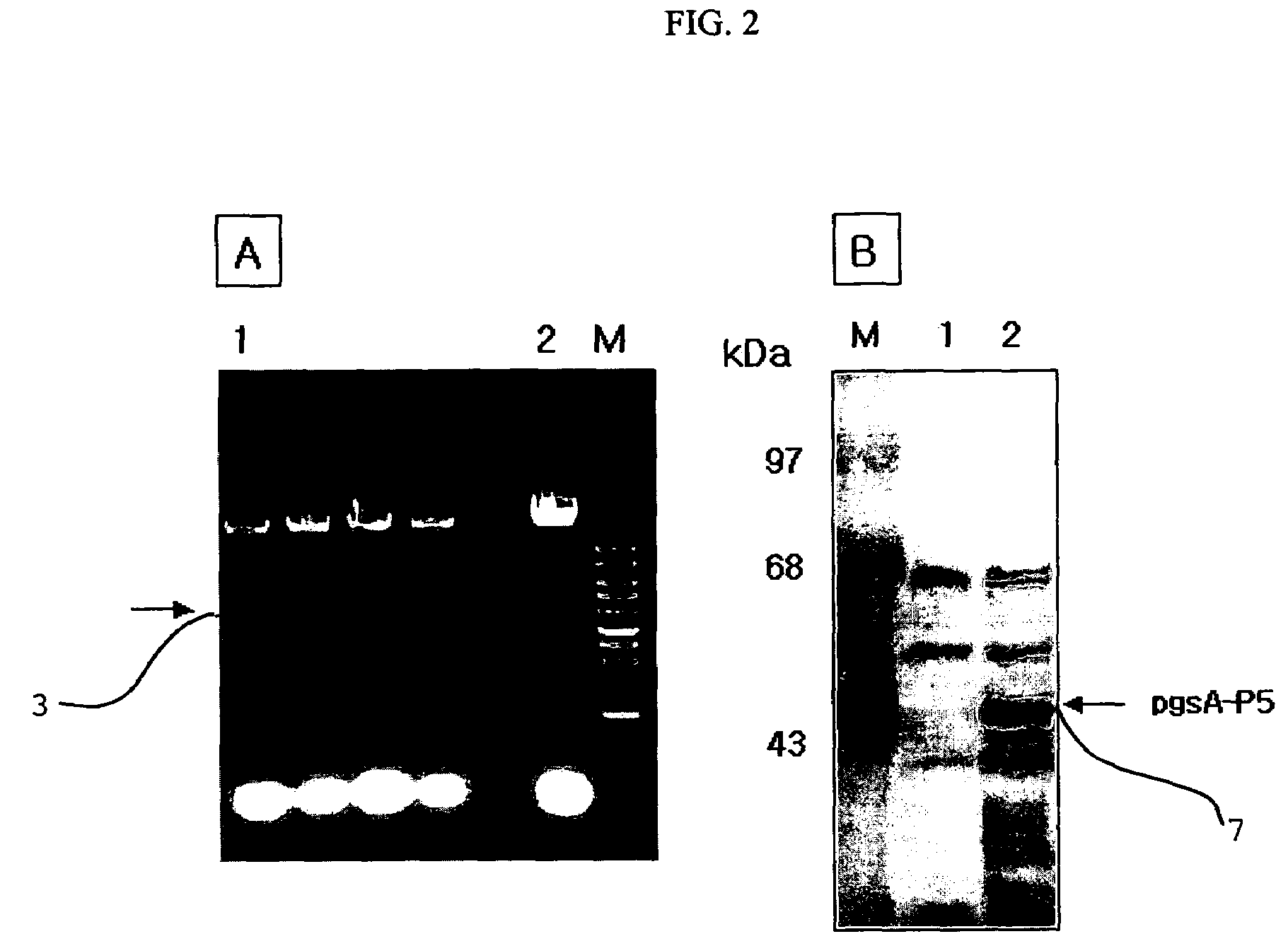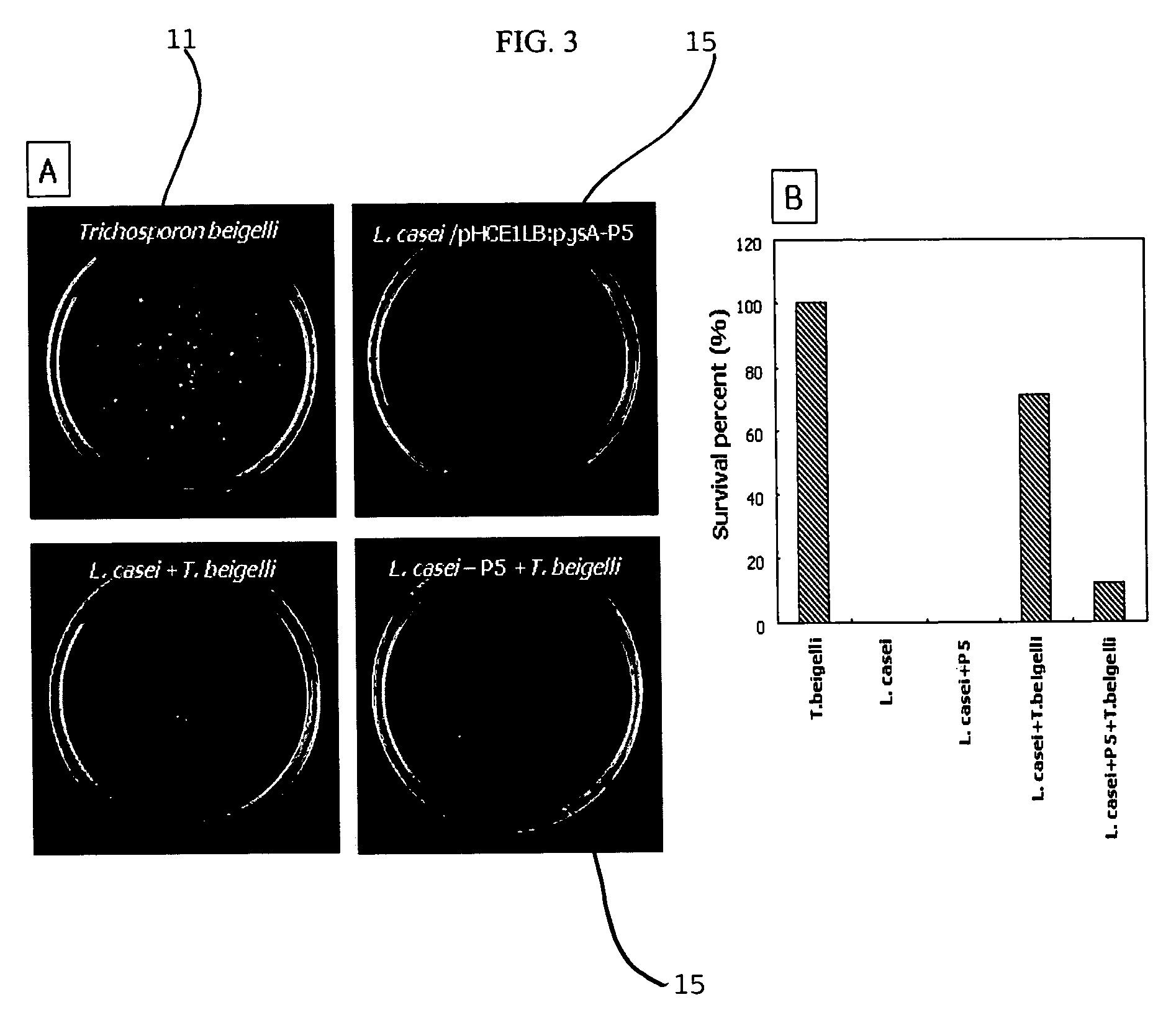Surface expression method of peptides P5 and Anal3 using the gene encoding poly-gamma-glutamate synthetase
a surface expression and polygamma-glutamate technology, applied in the field of surface expression of peptides p5 and anal3 using the gene encoding polygamma-glutamate synthetase, can solve the problems of low economic efficiency of peptide antibiotic production by chemical synthesis, the application of the above-mentioned peptide antibiotics, and the inability to provide low prices and large amounts, etc., to achieve effective expression, simple, easy and simple
- Summary
- Abstract
- Description
- Claims
- Application Information
AI Technical Summary
Benefits of technology
Problems solved by technology
Method used
Image
Examples
example 1
Production of Transformation Vector pHCE1LB:A-P5 For Surface Expression, and Surface Expression of Peptide P5 Fused with pgsA
[0049](1) Production of Transformation Vector pHCE1LB:pgsA-P5 1 for Surface Expression Against Peptide Antibiotics P5
[0050]FIG. 1 is a genetic map of the transformation vector pHCE1LB:pgsA-P5 1 for surface expression, which uses gram-negative and gram-positive microorganisms as hosts. The pgsA gene among the genes pgsBCA, which are derived from Bacillus subtilis var. chungkookjang (KCTC 0697BP) and involved in the synthesis of poly-gamma-glutamate, was inserted into the basic vector pHCE1LB using gram-negative and gram-positive microorganisms as hosts, thereby constructing intermediate vector pHCE1LB. In order to introduce peptide antibiotics P5-encoding gene into the intermediate vector, the intermediate vector was added with an oligonucleotide having the base sequences of SEQ ID NO: 4 and SEQ ID NO: 5, and denatured for 5 minutes at 95° C., followed by annea...
example 2
Measurement of Antifungal Activity of Lactobacillus Expressing Peptide Antibiotics P5 on Their Surface
[0057](1) In order to measure the antifungal activity of Lactobacillus which had been found in Example 1 to surface-express the peptide antibiotics P5, a visualization test of antifungal activity was conducted on pathogenic fungi Candida albicans (TIMM 1768) and Trichosporon beigelii (KCTC 7707).
[0058]Concretely, 50 μl of a PDB medium (20% potato infusion from, 2% Bacto-dextrose) containing 2×103 fungi was placed into each well of a 96-well plate, and 50 μl / well of MRS medium containing the Lactobacillus expressing the peptide P5 was successively diluted 1 / 2 times, and added to the fungi-containing well, followed by culturing at 37° C. for 16 hours. The cultured solution was plated on a PDB agar plate to visualize the strains. As a result, a large number of colonies could be found on the plates on which Trichosporon beigelii 11 and Candida albicans 21 themselves, and a mixture of su...
example 3
Production of Transformation Vector pHCE1LB:A-Anal3 for Surface Expression, and Surface Expression of Peptide Anal3 Fused with psA
[0062](1) Transformation vector pHCE1LB:A-Anal3 31, which can surface-express the peptide antibiotics Anal3, was produced in the same manner as in the part (1) of Example 1.
[0063]In order to introduce a peptide antibiotics Anal3-encoding gene into the intermediate vector pHCE1LB:pgsA, a genes having the base sequences of SEQ ID NO: 6 and SEQ ID NO: 7 and encoding the peptide Anal3 was annealed in the same manner as in Example 1, to give a 62-bp double helical sequence.
[0064]
SEQ ID NO 65′-ga tcc gcg aag aag gtg ttc aaa cgc ctg gag aagctg ttt agc aaa atc tgg aac tgg aag ta-3′:SEQ ID NO: 75′-aag cta ctt cca gtt cca gat ttt gct aaa cagctt ctc cag gcg ttt gaa cac ctt ctt cgc g-3′:
[0065]Both ends of the double helical sequence formed by the base sequences of SEQ ID NO: 6 and SEQ ID NO: 7 were so constructed that they have recognition sites for restriction enzym...
PUM
| Property | Measurement | Unit |
|---|---|---|
| pH | aaaaa | aaaaa |
| pore size | aaaaa | aaaaa |
| pH | aaaaa | aaaaa |
Abstract
Description
Claims
Application Information
 Login to View More
Login to View More - R&D
- Intellectual Property
- Life Sciences
- Materials
- Tech Scout
- Unparalleled Data Quality
- Higher Quality Content
- 60% Fewer Hallucinations
Browse by: Latest US Patents, China's latest patents, Technical Efficacy Thesaurus, Application Domain, Technology Topic, Popular Technical Reports.
© 2025 PatSnap. All rights reserved.Legal|Privacy policy|Modern Slavery Act Transparency Statement|Sitemap|About US| Contact US: help@patsnap.com



